Canon - Nikon comparison
A Comparison of Canon Rangefinder cameras and Nikon Rangefinder cameras
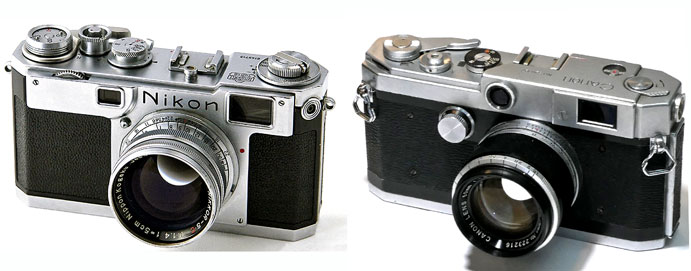
a Nikon S2 camera of 1956 and a Canon L2 camera of 1956
Rangefinder Cameras: Canon and Nikon
Canon and Nikon emerged during the 1950s as leading producers of interchangeable lens rangefinder cameras. Due to their quality and innovative designs, they surpassed all other camera manufacturers, with the exception of the creator of the 35mm rangefinder camera: Leica. However, another factor was important in the 1950's; a Leica M3 cost more than twice the price of similarly equiped Nikon or Canon cameras.
First as Seiki-Kōgaku and then as Canon Camera Company, Canon produced its rangefinder cameras earlier than Nippon Kōgaku (Nikon), and continued rangefinder production into the 1960s when Nikon had switched entirely to single lens reflex cameras. However, Canon's camera production prior to Nikon's 1948 camera introduction was of small volume. Also, what volume it did produce was nearly entirely with Nikon lenses, and in the early years with Nikon rangefinding technology.
Historically, when Seiki-Kōgaku developed its first camera, the Hansa Canon of 1936, it needed a lens for this 35mm format camera. Nippon Kōgaku was able to fulfill that need. The Hansa Canon featured a Nikkor 5cm f3.5 lens which was bayonet mounted into a Nikkor focusing mounting.
The optical company Nippon Kōgaku Kogyo - 日本光学工業株式会社 or "Japan Optical Industries Co., Ltd." had been created in 1917 during World War I, aided by the Imperial Japanese Navy and the Mitsubishi group. 20 Nippon Kōgaku was an important supplier of optical ordinance to the Japanese military, and particularly for the Japanese Imperial Navy. Some of the technological developments by Nippon Kōgaku were of benefit for their camera optics. For example, the Navy rangefinder shown below had some 26 different lenses and prisms. Nippon Kōgaku submarine periscopes had 33 lenses and prisms. The light loss and optical flare from each of the many lenses was an important problem. Nippon Kōgaku developed lens coating technology which improved optical performance and was used in Nikon lenses post-war.
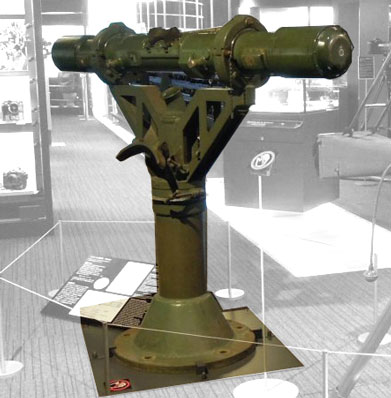
a Nikkor Navy rangefinder of World War 2 shown in the Nikon museum
This optical ordinance and other military manufacturing grew to very large volumes during World War II. 24 factories and 25,000 employees across Japan were ultimately employed. 20 They produced submarine periscopes, rifle scopes, binoculars, bomb sights, optical rangefinders, and aerial cameras. However, many of the Nippon Kōgaku factories producing military equipment were destroyed during the bombing raids of 1944-1945.
Post-war, Nippon Kōgaku was reorganized and reduced to one factory with 1,400 employees. 20 The company began to restart production of binoculars and other instruments for which they were already well-known - at least in Japan, if not internationally. Work also began on the design of a 35mm camera. From initial designs, on April 15, 1946, a production order for twenty prototype cameras was begun. Six months later, design was complete, which was further developed during 1947.
Nikon Model I
Nippon Kōgaku's design was intended to combine the best features of the Contax, Leica, and Canon rangefinders, while avoiding design features which added to complexity and reduced reliability. The initial Nikon is usually now refered to as the 'Nikon I'. The Nikon I, and its immediate successors the Nikon M (1949) and Nikon S (1951) all have the intial design characteristics defined by Nippon Kōgaku 1946-1948:
- the lens mount was a copy of the Contax bayonet mount
- focusing was by a wheel on the camera front operated by the photographer's right index finger focused regular and wide-angle lenses, similar to the Contax.

- the camera avoided the complex Contax vertically travelling focal-plane shutter. Instead it used a horizontally traveling cloth focal plane shutter such as Leica and Canon cameras.
- the rangefinder design was close to the Canon rangefinder, which Nippon Kōgaku had initially designed, and the Leica III rangefinder.
- for film loading, the entire back of the camera was removed, unlike the bottom-loading Leica and Canon.
In parallel with its development of the Nikon rangefinder camera, Nippon Kōgaku designed a series of lenses. The initial 'normal' lens was either a Nikkor 5cm f2.0 or Nikkor 5cm f3.5 lens, both collapible. Also offered was a 3.5cm f3.5, a 8.5cm f2.0 and a 13.5cm f4.0, all with excellent performance. Nippon Kōgaku's strength in lens designed offered a full lens range with the launch of its new Nikon rangefinder.
Nikon Model M
For reasons beyond the scope of this summary, the Nikon Model I, produced in very small numbers, was quickly followed in 1949 by the Nikon Model M. The Model M was identical with the Model I, except it advanced the 35mm film by one sprocket more than the Model I, allowing the film to be processed in the autormatic developing machines already in use and to mount in Kodak 35mm slide mounts. (The Model I used the smaller 'Nihon' image described in detail in the canonrangefinder.org page Minolta Rangefinders.)
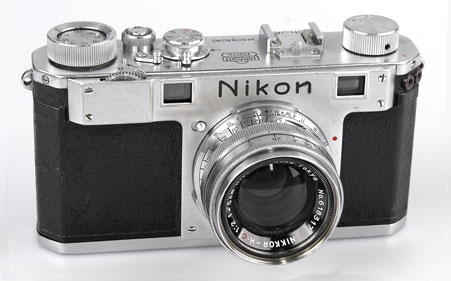
Nikon Model M of 1950 with Nikkor 5cm f2.0 lens and with flash synchronization
Approximately 3,200 units of the Nikon Model M were produced. 25 About half 1949-1950 were without flash synchronization, and the later half 1950-1951 had synchronization for flash bulbs (at 1/40 second) and for electronic strobe flash (at 1/20 second or slower). 25
Nikon Model S
Nippon Kōgaku introduced the Nikon Model S in 1951. Visually, it appeared identical to the later Model M cameras which had flash synchronization. Shutter speeds continued to be 1 to 1/500 second. It was now issued with the fine Nikkor 5cm f1.4 lens, the fastest lens of the era for rangefinder cameras. This camera was also the first Nikon model to gain significant sales outside Japan, due in part by their use by Life magazine and Look magazine photographers covering the Korean war. Then Nikon Model S gained international recognition due to its durability in all conditions, and the quality of the associated Nikkor lenses.
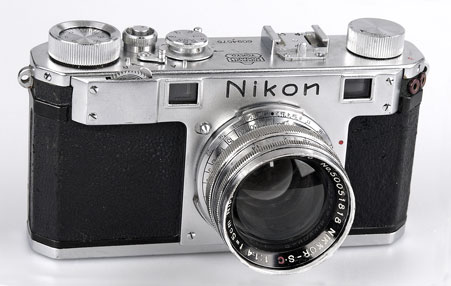
Nikon Model S of 1951 with Nikkor 5cm f1.4 lens which was the standard lens with the camera
The Nikon Model S was produced from 1951 to 1954 in some 35,200 units. 25 It was contemporaneous with the Canon rangefinder models IID, IID1, IIF, IIS, IIIA, IVF, IVS and the 1952 Canon IVSB. A clear difference between the Nikon and Canon commercial strategies were in these models. Nikon produced one rangefinder model, and sought to make it with as much precision and reliability as production techniques and materials then permitted. Canon, although using one type of rangefinder/viewfinder, and one shutter mechanism, offered many models with and without flash synchronization, and with shutter speeds in some models reachintg 1/1000 second and others at 1/500, with associated price segmentation.
The Canon viewfinder had an integrated viewfinder-rangefinder with rangefinder focusing superimposed in the viewfinder as did Nikon. Leica at this time had the rangefinder and viewfinder separated. Canon's finder also could be selected for 50mm, 100mm and 135mm lens viewing, whereas Nikon featured a 50mm image only.
Nikon Model S2
Nippon Kōgaku introduced what was to be its flagship camera, the Nikon Model S2 in December, 1954. The Nikon Model S2 represented a complete re-design of the Nikon rangefinder. Changes included: 26
- improving the the quality of the viewfinder with a bright parallax-corrected frame for 50mm lenses
- enlarging the negative size to the standard 24mm X 36mm size
- reducing the weight of the camera, with aluminium used in the body for the first time
- improvement of the flash and strobe synchronization, with a single coaxial connection
- addition of 1/1000 second to the high speeds, requiring speeding up the shutter curtain.
- improvement in the camera's ease of operation.
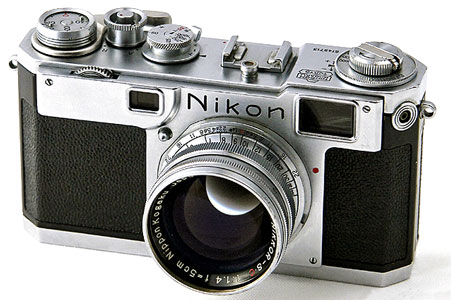
Nikon Model S2 of 1954 with Nikkor 5cm f1.4 lens
In some ways, the Nikon Model S2 was a response to the introduction of the Leica M3 which, although introduced in April, 1954 had prototype versions as early as 1952. 26 Like the Leica M3, the Nikon Model S2 which was introduced in December, 1954 had an enlarged and brighter viewfinder, which was further improved in 1955 and 1956.
In contrast, Canon in 1954 and 1955 did not introduce a new generation of rangefinder cameras, as had Leica and Nikon. The Canon IVSB2 was introduced in the summer of 1954, and although considered today by some 1 as the finest of the bottom-loading M39 rangefinder cameras, it was presented only as an update to the popular 1952 Canon IVSB. The Canon IVSB2 had an improved shutter, split at 1/30 second and with high speeds to 1/1000. Electronic flash synchronization at a 1/45 second position reduced 'ghosting'. The viewfinder was improved slightly with an enlarged eyepiece. In summary, a good camera, but not the beginning of a new generation for Canon.
Nikon Model SP
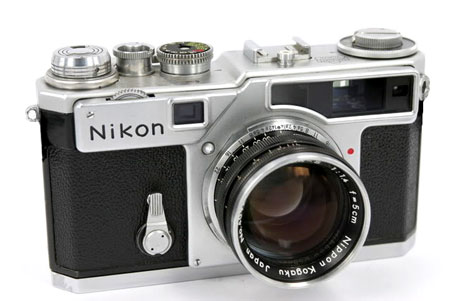
Nikon Model SP of 1957 with Nikkor 5cm f1.4 lens
Following three years of success of the Nikon S2, including the improvements mentioned above, in 1957, Nikon introduced the famous Nikon Model SP, or 'Professional' model. The camera featured the previous build quality and 'usability' of previous Nikon models, plus:
- and enlarged viewfinder with parallax corrected frames for 50mm, 85mm, 105mm and 135mm lenses
- a secondary viewfinder for 28mm and 35mm lenses
- a single non-rotating shutter speed dial with all speeds 1 second to 1/1000 second
- a compact and easy motor drive for 3 to 4 exposures per second
- Nikon continued to offer a full range of excellent coupled rangefinder lenses: 25mm, 28mm, 35mm, 50mm, 85mm, 105mm and 135mm, with only the 25mm lens requiring an auxiliary viewfinder.
During the years of the Nikon SP, Canon introduced a series of improved rangefinder models, including the VT deluxe, the L3, VL, VL2, VTDM, VI-L, VI-T and the Canon P. Only with the Canon VI-L and VI-T did Canon introduce a single non-rotating shutter speed dial which could couple with a Canon light meter mounted on the camera top. These cameras sold moderately well, but it was not until Canon introduced the Canon P that it experienced an important success.
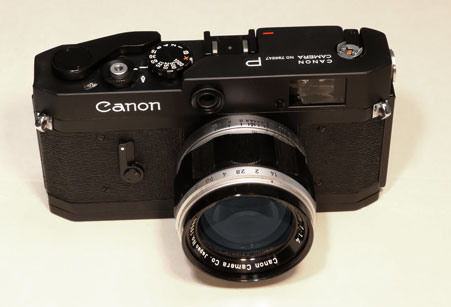
Canon P, sometimes called the 'Populaire', in black with the fine Canon 50mm f1.4 lens
In fact, the Canon P was so successful that it sold more than twice as many units as any previous Canon model. With sales of 87,875 units, it also sold more units than any Nikon rangefinder model ever made. Sales comparisons can be seen in the table below.
The success of the Canon P came from a combination of features representing what it came to be realized were most important to photographers from the introductory to the advanced level:
- a viewfinder that gave a 1:1 lifesize image with parallax-corrected bright line frames for 35mm, 50mm and 100mm lenses in a well illuminated image. This also provided ease of use of the increasingly popular 35mm lens in a life-size, parallax-corrected 35mm viewfinder image - not the case with Nikons or Leicas of that period. The Nikon and Leica viewfinders of that time also had smaller than 1:1 viewfinder images, so keeping both eyes open was not feasible with them.
- a single, non-rotating shutter speed dial which allowed easy connection to a light meter mounted to the camera top.
- a new shutter with 1/1000, B and X settings, with electronic flash synchronization speed of 1/55 second, reducing 'ghosting' with flash photography. Also, metal shutter curtains, preventing burning of the shutter curtain.
- lever film winding on the camera top, and a large pop-up film rewind crank.
- a combination of high quality construction with low price - 37,700 Yen with the 50mm f2.8 lens and 52,700 Yen with the 50mm f1.4 4. This was compared with the contemporary Canon VI-L and VI-T priced at 79,800 Yen with f1.8 lens, and the 1957 Nikon SP price of 98,000 Yen with f1.4 lens.
Canon also at this time offered an extensive range of lenses, the quality of which today is considered not second to the fine Nikkor lens range. These Canon lenses included:
- Canon 25mm f3.5
- Canon 35mm f1.5 and f2.8
- Canon 50mm f1.8, f1.8, f2.8
- Canon 85mm f1.9
- Canon 100mm f3.5
- Canon 135mm f3.5
All of these lenses were in a new alloy mount, except the 50mm f1.5.
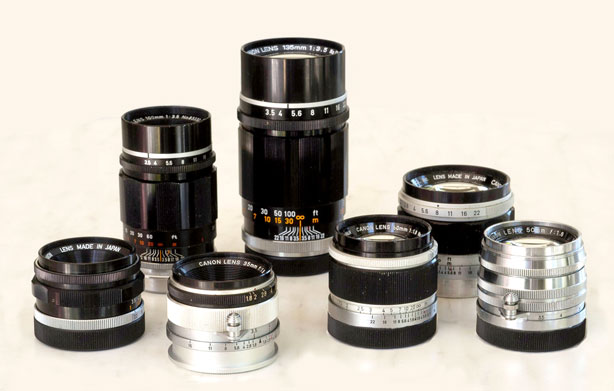
The Canon lenses of 1958-1959 (l to r):
Canon 35mm f2.0, 100mm f3.5, 35mm f1.8, 135mm f3.5, 50mm f1.8,
the excellent 50mm f1.4, and the solid chrome 50mm f1.5
Nikon Withdraws from the Rangefinder Market
In 1959, Nikon took the bold, and ultimately successful, strategic decision to end its development and production of 35mm rangefinder cameras, and to develop a new range of single lens reflex cameras. This lead to the famous Nikon F series of cameras. This new direction for Nikon is outside the scope of this page of the canonrangefinder.org site, but was a bold strategic decision. Canon, meanwhile continued to develop new generations of rangefinder cameras, including the Canon 7 of 1961 and the Canon 7s of 1965. These were both excellent rangefinder cameras - some of the best interchangeable rangefinders ever produced - but also commercially successful selling 137,250 units and 20,000 units respectively. Note that these sales were of more Canon cameras for these two models than the sales of all Nikon rangefinders of all models. Canon went on to develop single lens reflex camera systems, initially less successful than Nikon, but later including electronics and automation of great success - but also outside the scope of this canonrangefinder.org website.
Comparison of Nikon and Canon Commercial Strategies 1950s
As recounted above, Nikon and Canon had quite different commercial stragegies with their camera lines in the 1950s. Nikon produced one camera model and sought to make it as strong and precision as manufacturing of that period allowed. Canon in contrast produced many different camera models at the same time, and tried to segment the market with a variety of model variations and prices. As an example, during 1954-1957, Nikon offered the fine Nikon S2, usually with a 50mm f1.4 Nikkor lens. This sold for 98,000 Yen. In comparison, during this three year period, Canon offered:
- Canon IVSB2 - price 74,500 yen (with 50mm f1.8)
- Canon IID2 - price 48,000 yen (with 50mm f2.8)
- Canon IIS2 - price 78,500 yen (with 50mm f1.5)
- Canon VT - price 115,500 yen (with 50mm f1.2)
- Canon L1 - price 87,000 yen (with 50mm f1.2)
- Canon L2 - price 56,000 yen (with 50mm f2.8)
A futher comparison of the sales volumes of the Nikon and Canon cameras during the 1950s is shown in the table below. 1, 25
Camera comparison table
| Canon Model | Years Produced | Units Produced | Nikon Model | Years Produced | Units Produced |
|---|---|---|---|---|---|
|
IID IID1 IIF, IIS IIIA IVF, IVS IVSB
|
1952-1955 1952-1954 1951-1953 1951-1953 1953-1955 1952-1955 total |
21,725 2,400 13,750 9,025 6,900 34,975 88,775 |
Nikon S |
1951-1954 |
35,200 |
|
IVSB2 IID2 IIF2, IIS2 VT L1, L2
|
1954-1956 1955-1956 1955-1956 1956-1957 1956-1957 total |
16,800 16,175 19,200 15,575 15,325 83,075 |
Nikon S2 |
1954-1957 |
56,715 |
|
VT deluxe, L3 VL VL2 VTDM VI-L, VI-T P
|
1957-1958 1957-1958 1958-1958 1958-1958 1958-1960 1958-1960 total |
21,325 5,450 8,450 2,550 18,500 87,875 144,150 |
Nikon SP, S3, S4, S3M |
1957-1960 |
42,760 |
| Navigation: Click Below to Jump to Desired Subject Page | ||
|---|---|---|
| Canon Rangefinder Cameras - 1 | Canon Rangefinder Cameras - 2 | Canon Rangefinder Lenses |
| Canon Hansa | Canon IIAF, IIAX | Development Nikkor 50mm |
| Canon S | Canon IVSB2 | Canon 19mm |
| Canon J | Canon IIS2, IID2, IIF2 | Canon 25mm |
| Canon NS | Canon VT, Canon L2 | Canon 28mm |
| Canon JS | Canon L1, L3 | Canon 35mm |
| Canon S-I | Canon VT Deluxe | Canon 50mm |
| Canon J-II | Canon VL, VL2 | Canon 85mm |
| Canon S-II | Canon VI-L, VI-T | Canon 100mm |
| Canon IIB | Canon P | Canon 135mm |
| Canon III, IIC, IV | Canon 7 | Canon 200mm-1000mm |
| Canon IIIA, IVF, IVS | Canon 7s | Canon Accessories |
| Canon IIA, IID, IID1 | Nicca Rangefinders | Canon Finders |
| Canon IVSB | Leotax Rangefinders | Minolta Rangefinders |
| Canon IIF, IIS | Other Rangefinders | Minolta Lenses |
| Comparison Canon - Nikon Rangefinders | other M39 lenses | |
| Go to canonrangefinder.com home page | ||
Any additions or corrections to these pages would be welcome simply by contacting this site as shown at the foot of this page .
Footnotes:
1 Dechert, Peter. Canon Rangefinder Cameras 1933-1968. Hove Collectors Books. West Sussex, United Kingdom. 1985. ISBN 0-906447-30-5.
Peter Dechert's book is the most important expert source of information regarding Canon Rangefinder Cameras.
2 Kitchingman, Peter. Canon M39 Rangefinder Lenses 1939-1971. A Collector's Guide. Published by Peter Kitchingman. Perth, Australia. 2008. ISBN 978-0-646-48144-9.
Peter Kitchingman's book is the definitive study of the more than three decades of M39 format camera lenses developed for Canon Rangefinder Cameras.
3 Nostalgic Canon Camera Book. 懐かしいキヤノン EI Publishing Co. Ltd. Tokyo, Japan. June 2003.
Peter Kitchingman's book is the definitive study of the more than three decades of M39 format camera lenses developed for Canon Rangefinder Cameras.
4 "Canon Camera Museum" history website. https://global.canon/en/c-museum/history/ published by Canon, Inc. accessed in 2019.
5 Rajner, Hans P. (author), John Wade (editor). Leica Copies. Classic Collections Publications. London, UK. ISBN 13: 9781874485056
Hans P. Rajner's book is an excellently detailed and carefully researched study of camera from around the world which used the Leica M39 lens mount and the same lens to film plane distance.
7 Dechert, Peter. Canon Single Lens Reflex Cameras 1959-1991. Historical Camera Publications. Yakima, Washington. 1992. ISBN 1-879561-04-2.
8 Tomlinson, Shawn M. The Film Photography Book. Lulu Pulbications. 2016. ISBN: 9781365263972
9 Sartorius., Ghester. Identifying Leica Lenses. Classic Camera 19. Tokyo, Japan. 2001. ISBN 4-257-12029-0
10 website http://www.nicovandijk.net/rflensmatrix.htm consulted 2019.
11 O'Reagan, Douglas M. Allied Exploitation of German Science after World War II. Johns Hopkins University Press. Baltimore, Maryland. 2019. ISBN 9781421428888
12 website www.canonrangefinder.servehttp.com consulted 2008.
13 Minolta expert Andrea Aprà has posted information on minoltarangefinders group and other groups and further detailed information by email. (thanks Andrea !)
14 website http://www.collection-appareils.fr/objectifs/ consulted 2019.
15 Small, Marc James. Non-Leitz Leica Thread-Mount Lenses. Wittig Books. Hückelhoven, Germany. 1997. ISBN 3-930359-47-2.
16 the Nikon Corporation website: https://imaging.nikon.com/history/ consulted 2019.
17 p 152. Ray, Sidney F. Photographic Lens ISBN 9780240510323
18 website http://www.rokkorfiles.com/Lens%20History.html accessed 2019
19 Katz, Jerome. The Kardon camera story: a dedication to Peter Kardon, great American patriot & pioneer. SJF Enterprises. New York, New York. 1977.
20 Baird, John. The Japaneese Camera. The History of the Japanese Camera Monograph Collection. Historical Camera Publications. Yakima, Washington. 1990. ISBN 1-879561-02-6.
21 interesting website http://www.topgabacho.jp/Topconclub/Leotax.htm accessed 2019
22 Alexander, Jeffrey Scott. Nikon and the sponsorship of Japan's optical industry by the Imperial Japanese Navy 1923-1945. MA Thesis. University of British Columbia. 2001.
23 Alexander, Jeffrey Scott. Nikon and the sponsorship of Japan's optical industry by the Imperial Japanese Navy 1923-1945. PhD Thesis. University of British Columbia. 2010.
24 Lewis, Gordon, editor. Fujimura, Amy and Fujimura, William, translators. The History of the Japanese Camera. International Museum of Photography at George Eastman House. Tokyo and Rochester. 1991. ISBN 0-935398-17-1.
25 Rotoloni, Robert. Nikon Rangefinder Camera: An Illustrated History Hove Books Ltd. Sussex, UK. 1993. ISBN-13: 978-1874707073
26 Eastland, Jonathan. Dr. Leica M Compendium: Handbook of the Leica-M System Hove Books Ltd. Sussex, UK. 2006. ISBN-13: 9781897802052
If you have any comments or questions about this Leopold Stokowski site, please e-mail me (Larry Huffman) at e-mail address: [email protected]